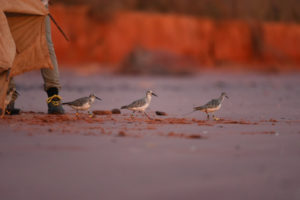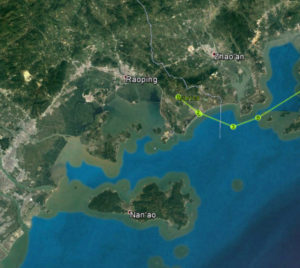Ginny (Ying Chi) Chan from Royal NIOZ Netherlands Institute for Sea Research and University of Groningen, The Netherlands, reports – observations from 9 April 2017:
On our quest to visit sites where the Great Knots (carrying 5 gr solar-powered satellite transmitters) are directing us, we ended up in Raoping, Guangdong, China. The Raoping site features a beach fringed by narrow mudflats, a habitat that seems more suitable for beach-dwellers like the Sanderling than for Great Knots. Nevertheless our satellite-tracked Great Knot stopped there. Worth to check it out!

The site we visited near Raoping, Guandong
Our first afternoon out was sunny and we encountered a small flock of Great Knots but our bird that according the tracks we received from its satellite transmitter should be here, was nowhere to be seen. Then a thick fog came. However just before sunset we realised a few other birds flew into our flock. And that included the satellite-tagged bird!

Great Knot with a satellite transmitter at Raoping, China. Photo: Ginny Chan


One and a half years ago, we caught it in Roebuck Bay, Northwest Australia and deployed the transmitter. (More about this work at Global Flyway Network Australia). I felt so glad to see this beautiful bird again with breeding plumage. Seeing the same bird in places more than 4500 km apart, made me marveled at their amazing super-journeys.

Roebuck Bay, Broome. Western Australia
Great knots with satellite transmitters being released in Roebuck Bay, Northwest Australia. Photo: Ivan Tse
Waders Roebuck Bay, Broome, W.Australia
Great Knots and other shorebirds at a roost in Roebuck Bay, Northwest Australia
It is great that we can observe this bird and its flock mates forage, and that we can sample their food. With the data we have collected at this site and other sites we hopefully will be able to explain why the birds choose this site, and why they stay for as long as they do.
The next morning we saw the bird with satellite transmitter again. The birds were very ‘jumpy’ and flew up very high at times. That is a sign that they were ready to migrate!
As we prepared this blog, on 30 April 2017, we know that the bird indeed left Raoping on 10 April 2017 to fly to the northern Yellow Sea. Since 13 April it is has been in Yalu Jang Nature Reserve near Donggang where it still is.
Vastleggen in volledig scherm 1-5-2017 120658.bmp
Flight path of the Raoping Great Knot. Position on 30 April 2017 was Yalu Jiang Nature Reserve

Curious fisherman observing how Hebo sorts out the sample. Photo: Ginny Chan

A flock of Great Knots over the sea. Photo: Ginny Chan

Finally, a team photo! Photo: Ginny Chan

No responses yet